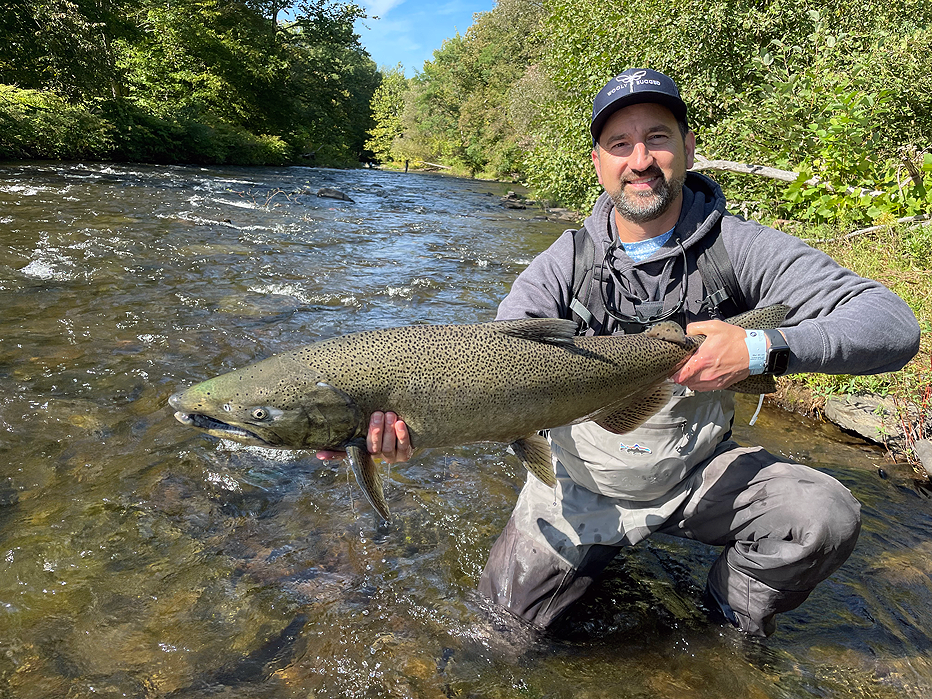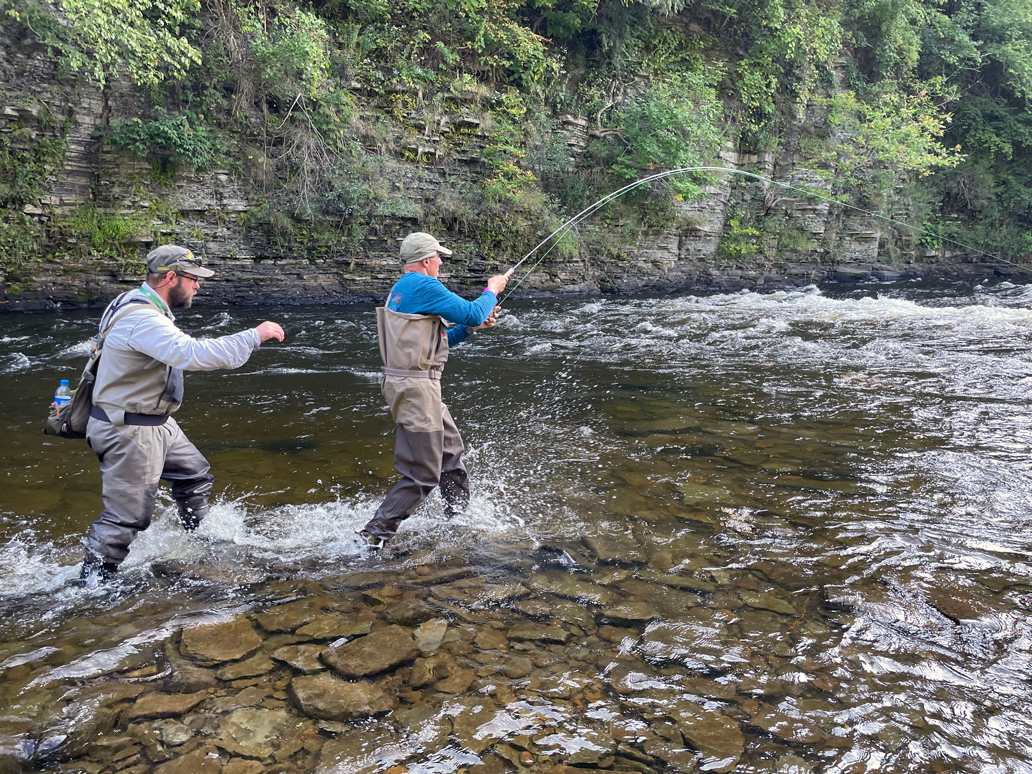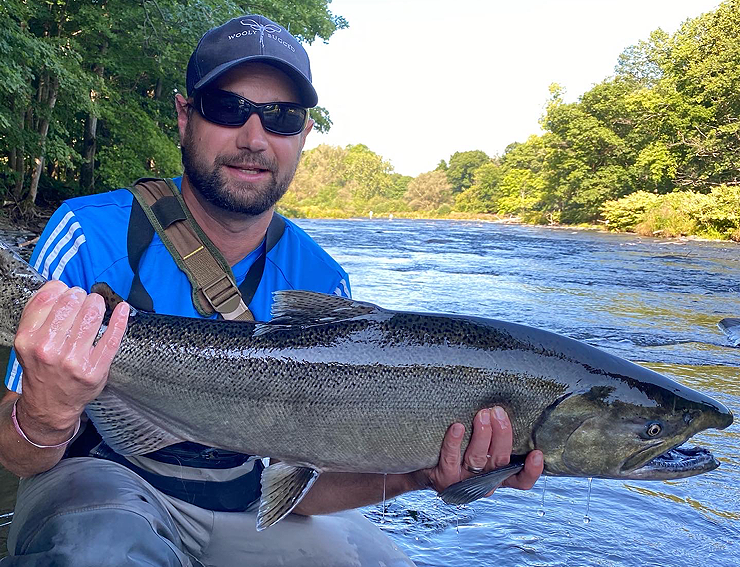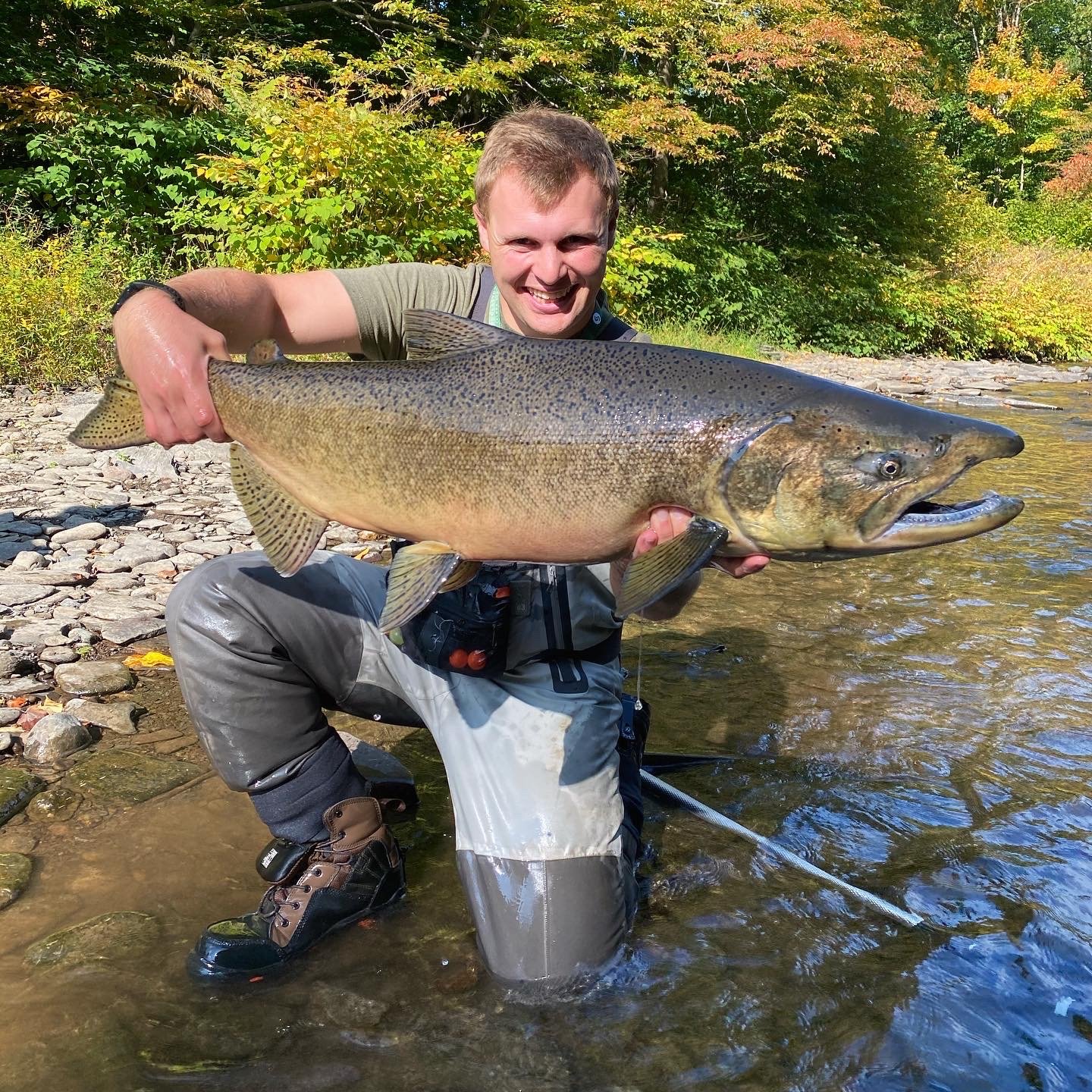One question I am asked more than any other is what type of fishing gear is required to fly fish for salmon in New York. There isn’t one answer to this question. Gear is determined by the style of fly fishing that’s being done and water conditions. Below I will cover the basics of what brought me success on my first several trips to the Salmon River and what you can use to drift fly patterns to entice territorial strikes from King or Coho salmon. This gear can also be used to fly fish for Atlantic salmon, as well as lake run steelhead and brown trout, however other techniques may prove more successful.
Wooly Bugged holding a large and territorial early September King salmon.
Fly Rod, Fly Reel & Fly Line
Wooly Bugged’s recommended starter fly rod, reel, and line for the Salmon River:
Fly rod style, action, length, and weight: Single-handed, medium-fast or fast, 9’-9wt or 10wt, 10’-9wt or 10wt with fighting butt
Fly reel size: 8/9/10 large diameter and large arbor reel (balanced to rod) with 150 yards of 20 lb. backing
Fly line: WF (Weight Forward) floating line that matches the rod weight
Fly Rod Overview
The average King salmon a fisherman will encounter on the Salmon River weighs 15-20 lbs. Most of the fish you’ll encounter in the Salmon River are big, especially to someone who is accustomed to fly fishing for trout on small freestone or limestone creeks. Big fish take longer to land, especially those fresh out of the lake, and taking too long to land a big fish on the Salmon River means tired fish and annoyed fishermen. Every year I’m in Pulaski, I witness a new fisherman hook-up with a salmon on a 5wt fly rod and then follow the fish up and down the river, sometimes over more than a hundred yards, disrupting other fisherman multiple times in the process. Sometimes this scene might include the guy who is hooked up standing in the middle of a popular fishing run while his salmon is sitting on the bottom of the river, and he is incapable of getting the fish to move. Fishermen on the Salmon River expect to be disrupted, but when the same individual comes over their head with a line three or four times because their fly rod doesn’t have enough backbone, there are going to be some frustrated looks and probably some unhappy words spoken. Why am I telling you all of this? Because I was this guy on my first trip to the Salmon River. One way you can avoid being “that guy” is to make sure you bring a fly rod that is the appropriate weight.
I recommend that anyone heading to chase salmon on the fly in New York start with a 9’ or longer fly rod with a 9wt or higher rating. Although not required, I’ve found that a longer rod is more desirable because it will make casting and drifting patterns easier on your arms and shoulders during a full day of fishing. Although it is a standard feature on most modern 7wt to 12wt fly rods, make sure the rod you choose for salmon fishing has a fighting butt handle design. Battling a King salmon on a single-handed fly rod can exhaust your arms quickly and being able to create a fulcrum with the fighting butt against your body will make things easier.
Guide Rick Smith coaching a first time fly fisherman on how to fight a King salmon on a fly rod.
Fly Reel Overview
The fly reel you choose will also play a critical role in your ability to land a salmon. I recommend an 8/9/10 size fly reel that is appropriately balanced with your fly rod. Here are additional factors you’ll want to consider when choosing a fly reel for salmon.
Drag System - There are two primary types of reel drag systems, disk drag (and there are many variations of disk drag) and click-paw drag. The disk drag design is common on most of today’s fly reels and is my choice for fighting salmon. The disk drag offers a wider range of pressure control and more big fish stopping power than a spring-loaded click-paw reel. It allows the angler to tighten the drag down so a large fish like a salmon will ramp up the speed on the reel evenly. Some fly fishermen use a click-paw drag style reel for salmon and then add additional pressure by “palming” the reel to slow the fish down. This can be a dangerous practice for inexperienced fly fishermen and can lead to bloody knuckles or a dislocated finger as a salmon can increase the reel speed and revolution of the handle quickly.
Line Capacity & Retrieval Rate - Fly reels are sold with different diameters (overall reel size) and arbor sizes (size of the reel core that holds the line) which directly impacts their line capacity. Because salmon are such a large fighting fish, long runs downriver are not uncommon. A fresh King or Coho salmon can pull 100 yards of line off your fly reel in a few seconds. Because of this, I recommend a fly reel with a larger diameter that can hold a full fly line and at least 150 yards of backing. Additionally, a fly reel with a large arbor allows for faster line retrieval because it pick-ups more line off the water with each revolution. Being able to retrieve line quickly while salmon fishing is critical. The salmon will tear line off your reel, then suddenly change direction, sometimes coming directly at you. Being able to get your line off the water and back onto your reel as quickly as possible can lead to more landed fish.
Durability - One thing I learned quickly about being a successful fly angler for salmon is that your reel will take a beating. There is a high probability that at some point you will attempt to follow a fish on its run downriver and slip, stumble, or fall with your rod in hand. At some point you will drop your rod. There’s a high likelihood you will need to quickly set your rod down on rocks so you can tail or hold a fish. My experience has been that reels that are machined and have an anodized surface will provide greater durability in these conditions. They will do a better job of resisting scratches, dings, and deformity. I’ve had cast reels break on me while fighting King salmon. Reels that have the handle cast into the reel frame have broken on me several times.
When considering fly line for salmon, I tell a first timer that a WF (Weight Forward) floating line that matches the weight of your fly rod is the place to start. The floating line will allow you to drift various nymphs, eggs, and Wooly Bugger patterns. Once you get some experience under your belt, then consider fly lines that mend or sink differently.
Matt Fuddy holding a large King salmon he landed on 12 lb. monofilament tippet.
Leader & Tippet
Wooly Bugged’s recommended starter leader and tippet for the Salmon River:
Leader: 9’-12 lb. test (tapered)
Tippet: 10-12 lb. test (nylon monofilament or fluorocarbon)
The leader and tippet and how you connect them to the fly line, each other, and the fly will be critical to successfully landing a salmon. When a salmon strikes your fly and you set the hook, it may be like trying to stop a freight train. This will expose any poor line connections, so take your time tying knots and check them twice prior to casting your line.
Fly fishermen often debate whether or not a fluorocarbon leader and tippet is required for salmon fishing. After extensively researching this topic, here is what I’ve concluded:
Abrasion Resistance - Nylon monofilament and fluorocarbon fishing lines are so close in abrasion resistance performance that I can’t recommend one over the other. Some of you will read this and disagree, but tests like this one, although not perfect, gave me a new perspective.
Sink Rate - Fluorocarbon line has a higher material density than monofilament and sinks faster, however, most fly fishing rigs for salmon involve a weighted fly or line. You’ll have to determine if this factor offers you an advantage.
Visibility - The refractive light index of fluorocarbon fishing line is closer to that of water than monofilament line, making it less visible in the water. Regardless of claims, no fishing line is entirely invisible to fish. I do believe in salmon fishing, especially clear water conditions, that light refraction does come into play. This is a factor I’ve experienced in person several times on the Salmon River. I remember fishing the lower Douglaston Salmon Run one afternoon when a large school of fresh salmon pushed into the run. I was fishing next to a guy who was dead drifting an estaz egg pattern with a fluorocarbon leader and tippet. He was hooking King salmon in the mouth on almost every cast. I was fishing an almost identical set-up but I was using a monofilament tippet and leader. I observed the fresh salmon adjusting their swimming lane when my line drifted through the run. The late afternoon sun was positioned in a way that it was hitting our lines and I believe the light refraction made a difference.
Leaders and tippet made of fluorocarbon are significantly more expensive than monofilament. Based on the factors I’ve outlined above, combined with your own experiences, you’ll have to decide what you believe the best choice is.
Nate Liscum with a giant King salmon he caught using a weighted fly pattern.
Weight & Accessories
Wooly Bugged’s recommended weight and optional accessories for the Salmon River:
Weight: Split shot or weighted flies (see regulations below), variety of sizes pending water conditions, material of preference (Tin or Tungsten is preferred, many fishermen still use lead, but note that sales of small lead fishing weights are banned in New York because the weights can have a detrimental impact on wildlife)
Optional Accessories:
Barrel Swivels: Sizes #7, #8, #10
Strike Indicators: Large size Lightning Strike, Thingamabobber, Air Lock indicators
Most fishing situations on the Salmon River will require weight to get your fly presentation in front of the salmon. The amount of weight required will be dictated by the water conditions and where the fish are positioned in the water column. Water conditions will change depending where and when you are fishing. If you are fishing deeper or faster water, naturally more weight will be required to get your fly presentation down to the fish. However, if the salmon are not positioned on the bottom and are instead positioned in the middle water column as they rocket upriver, your weight needs to be adjusted accordingly. The salmon river has a lot of diverse features. Walking a couple of miles of the river, you will encounter deep holding pools, narrow and wide riffle water, and long flat shallow water. Brookfield Renewable Power conducts water releases from the Lighthouse Hill Reservoir throughout the early salmon season and this can raise the Salmon River flows to conditions where weight will be required in most areas. In some situations, a weighted fly may be more effective than split shot positioned above the fly. Where your weight should be positioned, how much weight, and how to get your fly to where the fish are positioned, these are all things that come with experience.
George Zervos of On The Fly Guide Service giving tips to my father on how to land a King salmon.
One thing that is critical to know is that the state of New York has special regulations related to how weight is used on a fishing rig and some of those regulations are specific to fly fishing. I highly recommend you regularly update yourself on these regulations to ensure that while you are fishing you are abiding by all state laws. Additionally, the Douglaston Salmon Run has additional regulations that anyone fishing their property should be aware of. I’ve outlined at a high-level the weight related regulations specific to fishing the Salmon River below:
New York State Weight Regulations for Lake Ontario Tributaries
(During major salmon seasons, September through October, as of 2022, see full New York regulations here)
Positioning Weight on The Line:
“The distance between the hook, artificial fly or lure, and any weight attached to the line or leader, whether fixed or sliding, shall not exceed four feet.”
“Any weight added to the line, leader, swivels, artificial fly, or lure shall not hang lower than the hook when the line or leader is held vertically.”
Weighted Fly Design:
“Use of hooks with added weight is prohibited, except artificial flies and jigs weighing no more than 1/8 oz.”
Douglaston Salmon Run Weight Regulations
(In addition to New York State regulations, see full DSR regulations here)
“A breakpoint (knot or swivel) must be used to prevent added weight from sliding down the fishing line to the hook producing a snagging device. A maximum distance of 48” and a minimum of 12” from the break point & added weight to the hook will be strictly enforced.”
“Any weight added to a line must be placed above a breakpoint.”
“If a sink tip is being utilized, a breakpoint is NOT required. If supplemental weight is utilized in addition to a sink tip, a breakpoint would be required.”
If you missed Part 1 of this series, you can find it here.





